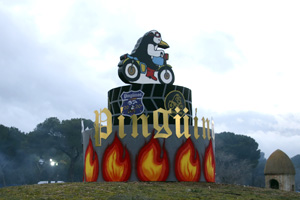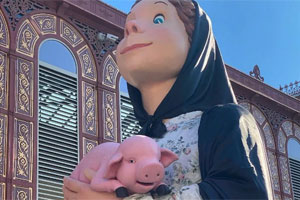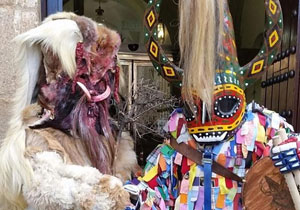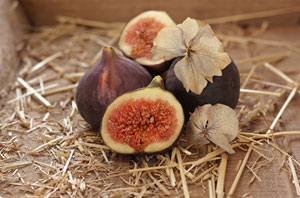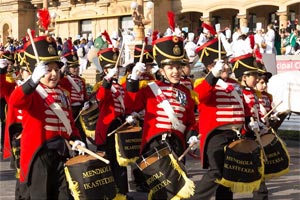Fiesta de los Rehiletes in Aracena
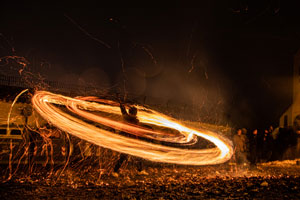
On 7 December, the Sierra de Aracena is dressed in fire and festive warmth as it celebrates the Fiesta de los Rehiletes in Aracena.
We invite you to enjoy a magical date to learn more about this colourful festivity, whose central element are the "rehiletes", the children and the fire.
Featured photo: Francisco Delgado Carrión.
What does the Fiesta de los Rehiletes in Aracena consist of?
The Fiesta de los Rehiletes in Aracena is a festivity that takes place every 7th December in Aracena, on the eve of the celebration of the festivities in honour of the Immaculate Conception. Numerous bonfires and bonfires are organised in the squares of the neighbourhoods of this town for the incineration of the rehiletes, with a purifying and traditional meaning.
How are the Rehiletes celebrated?
This popular festival begins on the eve of the feast of the Immaculate Conception with the making of the rehiletes, in which the local children participate. In the days prior to the Fiesta de los Rehiletes, the wood for the bonfires is gathered, as well as the leaves of the chestnut trees, which are inserted into olive tree sticks.
At dusk, bonfires are built in all the squares of the region and the logs are set on fire. It is amazing to see the fireworks burning as you bring them close to the fire, holding the stick and spinning them in a circular motion. A golden ring or circle is formed, a spectacle worth seeing with the Sierra Aracena in the background, the perfect landscape.
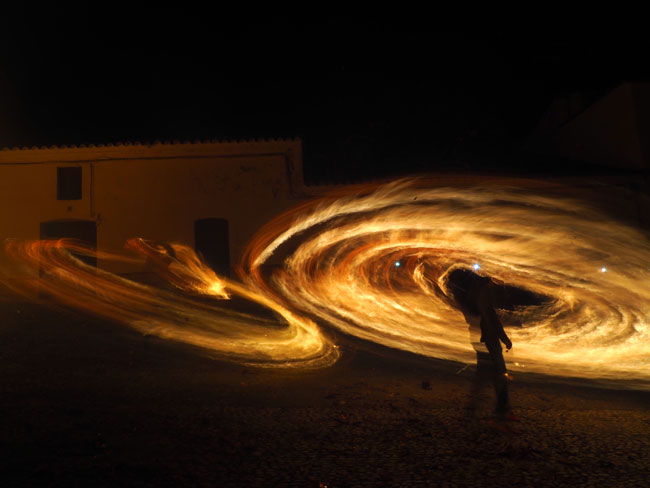
The main protagonists of this festivity are the children, making harmonious movements with their burning rehiletes, with the proper safety measures and adult supervision.
After the burning of the rehiletes, the delicacies typical of this popular festival are prepared: meat, must and Iberian pork sausages. Locals and visitors enjoy a warm and convivial evening until the early hours of the morning.
Origins of the celebration of the Fiesta de los Rehiletes in Aracena
The exact origin of this popular festival is unknown. However, it is said to have a strong agricultural, religious and pagan character. The Fiesta de los Rehiletes is one of Aracena's most ancient and deep-rooted festive expressions. It is an ancient tradition to go to the chestnut grove to collect the dried leaves to make the 'rehiletes'. This symbolically represents the preparation of the land for the winter, celebrating the end of the chestnut harvest, and on the other hand, the fire represents purification.
Curiosities of the Fiesta de los Rehiletes in Aracena
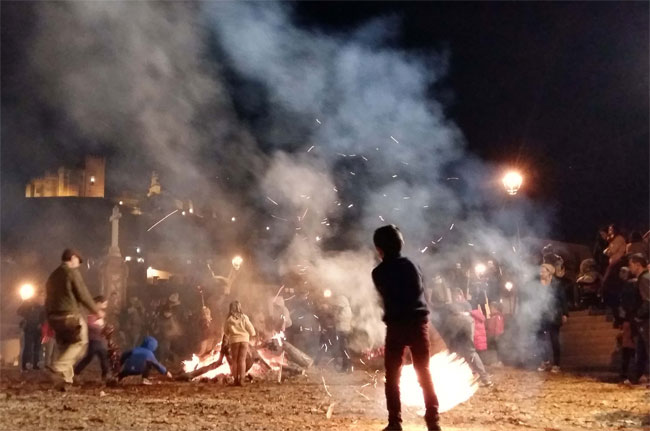
Find out some curious and interesting facts about the Fiesta de los Rehiletes in Aracena:
- Annually the Aracena Town Council, through the Social Welfare Council, organises the Tostón Solidario de Castañas during the night of the burning of the rehiletes. It is a charity event in which 100 kilos of chestnuts are roasted. It is a great roasting, the aim of which is to raise funds for a social project.
- A photographic competition is held, with the participation of professional and amateur photographers. Prizes are awarded for the best images that capture the effect of the spirals of fire generated by the burning of the firecrackers.
Recommendations for visitors
If you want to enjoy these festivities to the full, here are some recommendations and practical tips:
- Wear comfortable clothes and footwear.
- Supervise children and youngsters when handling the fireworks.
What else can you see or do in the town if you go to Aracena?
We invite you to visit some places of historical and cultural interest in Aracena:
- Castillo Fortaleza: a building built on the site of an ancient Muslim fortress in the 13th century, considered an Asset of Cultural Interest since 1931.
- Convent of Jesus, Mary and Joseph: it was a convent of nuns of the Dominican Order built in the 17th century, of Baroque architecture.
- Hermitage of San Roque: Mudejar style hermitage, with beautiful transversal interior arches.
- Gruta de las Maravillas: stalactite cave with a large underground lake that was discovered at the end of the 19th century. It was opened to the public in 1914, being the first tourist cave in Spain.
- Church of Nuestra Señora de los Dolores: this is the oldest Gothic church in Aracena. It was built between the 13th and 15th centuries and has been considered an Asset of Cultural Interest since 1931.
- Museum of Contemporary Sculpture: it is an open-air sculpture museum, inaugurated in 1986.
- Museo del Jamón de Aracena: the "Museo del Jamón, Centro de Interpretación del Cerdo Ibérico" is a space of 1,600 m2 that shows everything related to the influence of the Iberian pig in the heritage culture of the region.
Gastronomy
We invite you to enjoy the typical gastronomy of the Sierra de Aracena:
- Ajo gañán: typical tapa from Aracena made with boiled potatoes, bread, red pepper, garlic and cumin.
- Albóndigas de chocos (cuttlefish meatballs): prepared with cuttlefish, chilli pepper and saffron.
- Coquinas al ajillo: made with coquinas, sliced garlic, fish stock, bay leaf and parsley.
- Gañotes: sweet dough in the shape of a spiral, prepared with sesame seeds, lemon zest and olive oil.
- Mojama de atún: strips of tuna loin meat are marinated in salt, seasoned with olive oil and accompanied with nuts.
- Patatas con Choco: a stew prepared with potatoes, cuttlefish or cuttlefish and a sauce made with tomato, onion, garlic and peppers.
- Potaje de Castañas (chestnut stew): typical dessert with chestnuts, bread, orange and lemon peel, aniseed, cloves and cinnamon.
- Raya al pimentón: prepared with boiled skate, fried garlic, bread, sweet paprika and bay leaf, accompanied by boiled potatoes or vegetables.
Share images, videos and interesting information about the Fiesta de los Rehiletes in Aracena on social networks. Use the hashtags #Rehiletes #Aracena

